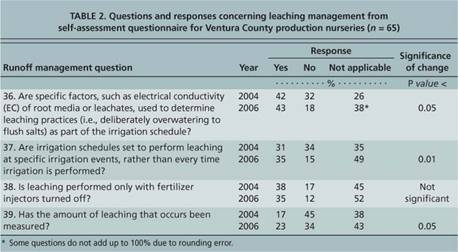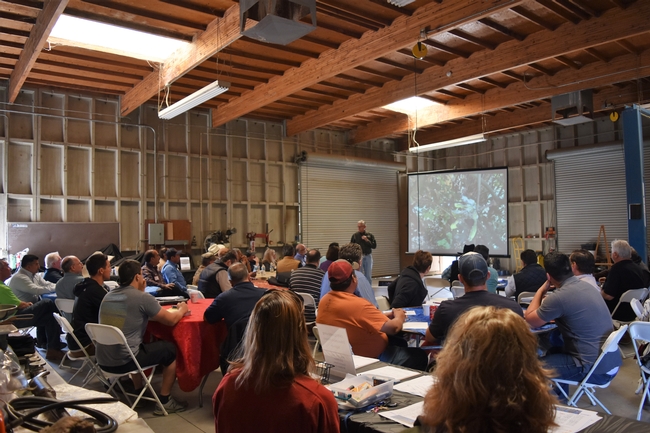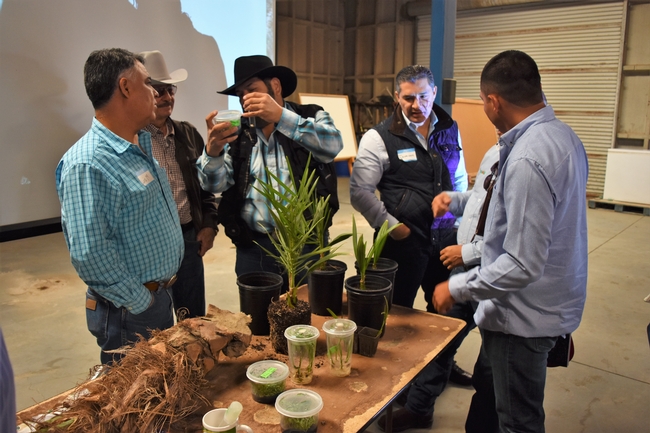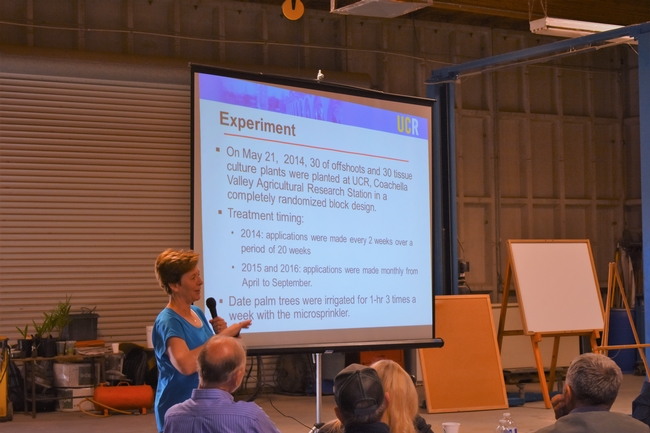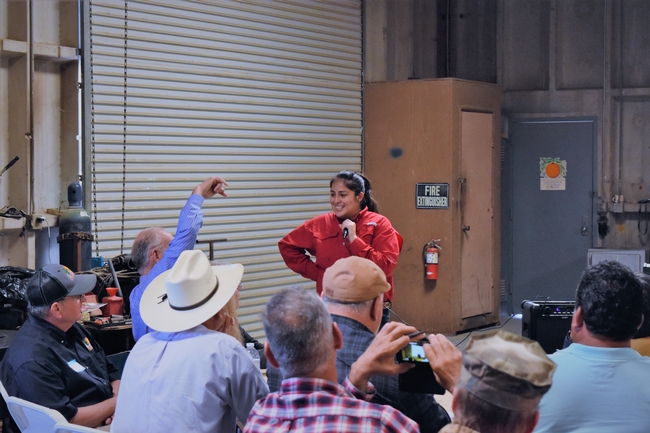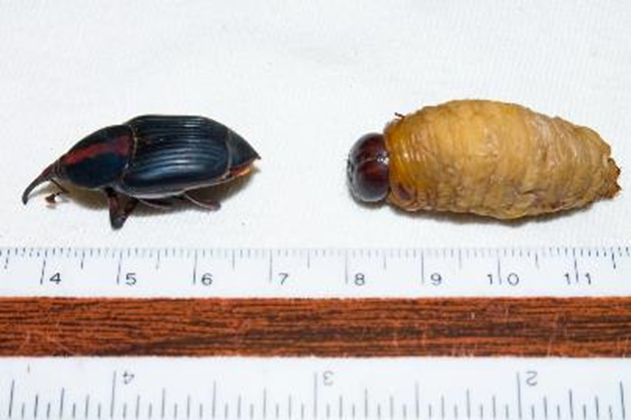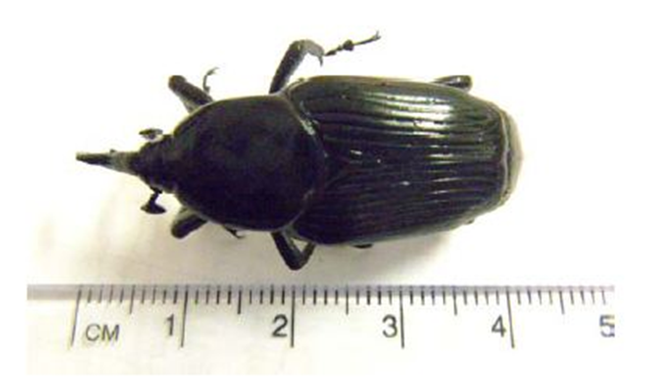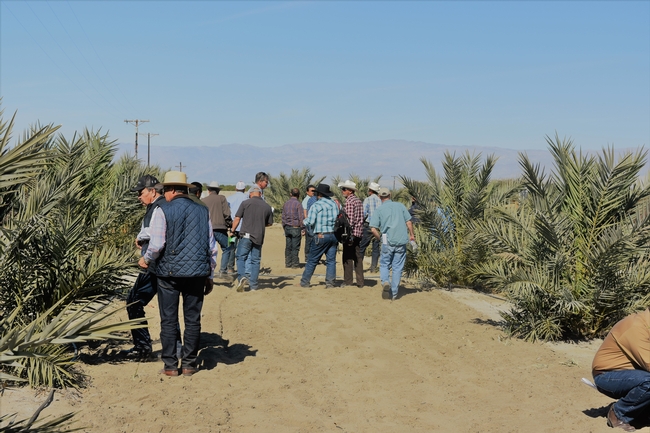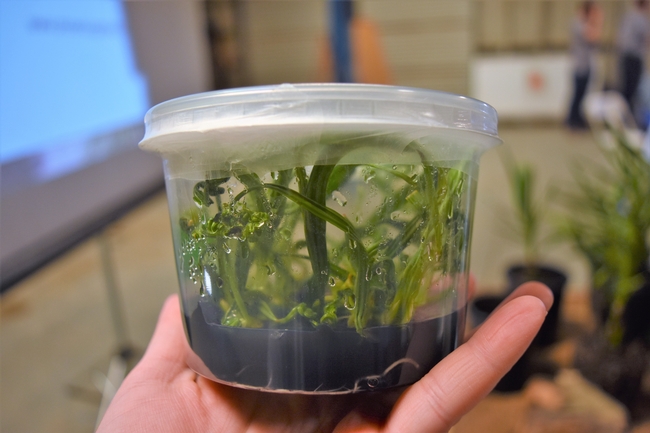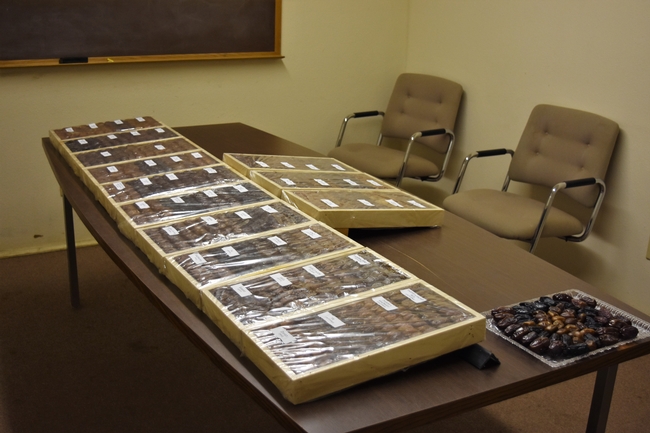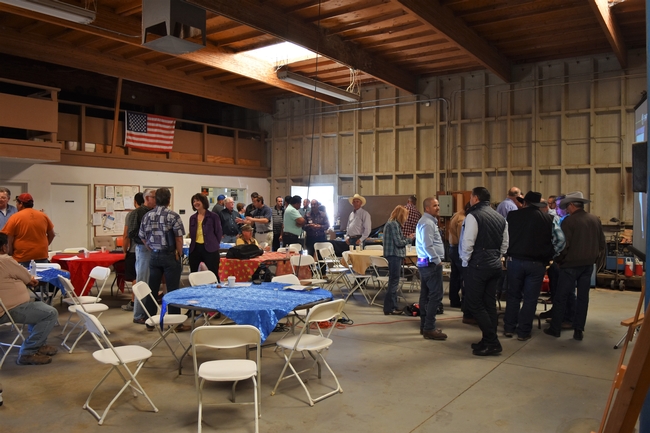
Posts Tagged: tissue
Now is the Time to Sample Citrus for Nutrients - and Avocados Too
University of California (UC) researchers and private industry consultants have invested much effort in correlating optimal citrus tree growth, fruit quality and yield to concentrations of necessary plant nutrients in citrus (especially orange) leaf tissue. The grower can remove much of the guesswork of fertilization by adhering to UC recommendations of critical levels of nutrients in the tissues of appropriately sampled leaves. Optimal values for elements important in plant nutrition are presented on a dry-weight basis in Table 1. Adding them in appropriate rates by broadcasting to the soil, fertigating through the irrigation system or spraying them foliarly may correct concentrations of nutrients in the deficient or low range. Compared to the cost of fertilizers, and the loss of fruit yield and quality that can occur as a result of nutrient deficiencies or excesses, leaf tissue analysis is a bargain. At a minimum, the grower should monitor the nitrogen status of the grove through tissue sampling on an annual basis.
Leaves of the spring flush are sampled during the time period from about August 15 through October 15. Pick healthy, undamaged leaves that are 4-6 months old on non-fruiting branches. Select leaves that reflect the average size leaf for the spring flush and do not pick the terminal leaf of a branch. Typically 75 to 100 leaves from a uniform 20- acre block of citrus are sufficient for testing. Generally, the sampler will walk diagonally across the area to be sampled, and randomly pick leaves, one per tree. Leaves should be taken so that the final sample includes roughly the same number of leaves from each of the four quadrants of the tree canopy. Values in Table 1 will not reflect the nutritional status of the orchard if these sampling guidelines are not followed. Typically, citrus is able to store considerable quantities of nutrients in the tree. Sampling leaves from trees more frequently than once a year in the fall is usually unnecessary. A single annual sample in the fall provides ample time for detecting and correcting developing deficiencies.
Table 1. Mineral nutrition standards for leaves from mature orange trees based on dry-weight concentration of elements in 4 to 7 month old spring flush leaves from non-fruiting branch terminals.
|
element |
unit |
deficiency |
low |
optimum |
high |
excess |
|
|
|
|
|
|
|
|
|
N |
% |
2.2 |
2.2-2.4 |
2.5-2.7 |
2.7-2.8 |
3.0 |
|
P |
% |
0.9 |
0.9-0.11 |
0.12-0.16 |
0.17-0.29 |
0.3 |
|
K (Calif.*) |
% |
0.40 |
0.40-0.69 |
0.70-1.09 |
1.1-2.0 |
2.3 |
|
K (Florida*) |
% |
0.7 |
0.7-1.1 |
1.2-1.7 |
1.8-2.3 |
2.4 |
|
Ca |
% |
1.5 |
1.6-2.9 |
3.0-5.5 |
5.6-6.9 |
7.0 |
|
Mg |
% |
0.16 |
0.16-0.25 |
0.26-0.6 |
0.7-1.1 |
1.2 |
|
S |
% |
0.14 |
0.14-0.19 |
0.2-0.3 |
0.4-0.5 |
0.6 |
|
Cl |
% |
? |
? |
<0.03 |
0.4-0.6 |
0.7 |
|
Na |
% |
? |
? |
<0.16 |
0.17-0.24 |
0.25 |
|
B |
ppm |
21 |
21-30 |
31-100 |
101.260 |
260 |
|
Fe |
ppm |
36 |
36-59 |
60-120 |
130-200 |
250? |
|
Mn |
ppm |
16 |
16-24 |
25-200 |
300-500? |
1000 |
|
Zn |
ppm |
16 |
16-24 |
25-100 |
110-200 |
300 |
|
Cu |
ppm |
3.6 |
3.6-4.9 |
5 - 16 |
17-22? |
22 |
*California and Florida recommendations for K are sufficiently different that they are presented separately. The California standards are based on production of table navels and Valencias, and those for Florida were developed primarily for juice oranges like Valencia.
The sampled leaves should be placed in a paper bag, and protected from excessive heat (like in a hot trunk or cab) during the day. If possible, find a laboratory that will wash the leaves as part of their procedure instead of requiring the sampler to do this. Leaf samples can be held in the refrigerator (not the freezer) overnight. Leaves should be taken to the lab for washing and analysis as quickly as is feasible.
Often separate samples are taken within a block if areas exist that appear to have special nutrient problems. The temptation encountered in sampling areas with weak trees is to take the worst looking, most severely chlorotic or necrotic leaves on the tree. Selecting this type of leaf may be counter-productive in that the tree may have already reabsorbed most of the nutrients from these leaves before they were sampled. A leaf-tissue analysis based on leaves like this often results in a report of general starvation, and the true cause of the tree decline if the result of a single nutritional deficiency may not be obvious. Often in weak areas, it is beneficial to sample normal appearing or slightly affected leaves. If the problem is a deficiency, the nutrient will, generally, be deficient in the healthy-looking tissue as well.
Groves of early navels that are not normally treated with copper and lime as a fungicide should include an analysis for copper. Copper deficiency is a real possibility on trees growing in sandy, organic, or calcareous soils. For later harvested varieties, leaves should be sampled before fall fungicidal or nutritional sprays are applied because nutrients adhering to the exterior of leaves will give an inaccurate picture of the actual nutritional status of the tree.
Usually leaf samples taken from trees deficient in nitrogen will overestimate the true quantity of nitrogen storage in the trees. Trees deficient in nitrogen typically rob nitrogen from older leaves to use in the production of new leaves. Frequently, by the time fall leaf samples are collected in nitrogen deficient groves, these spent spring flush leaves have already fallen. Nitrogen deficient trees typically have thin-looking canopies as a result of this physiological response. Since the spring flush leaves are no longer present on the tree in the fall when leaves are sampled, younger leaves are often taken by mistake for analysis. These leaves are higher in nitrogen than the now missing spring flush leaves would have been and provide an inaccurately higher nitrogen status in the grove than actually exists.
Critical levels for leaf-nitrogen for some varieties of citrus, like the grapefruits, pummelos, pummelo x grapefruit hybrids and the mandarins, have not been investigated as well as those for oranges. However, the mineral nutrient requirements of most citrus varieties are probably similar to those for sweet oranges presented in Table 1, except for lemons, where the recommended nitrogen dry-weight percentage is in the range of 2.2- 2.4%.
A complete soil sample in conjunction with the leaf sample can provide valuable information on the native fertility of the soil with respect to some mineral nutrients and information on how best to amend the soil if necessary to improve uptake of fertilizers and improve water infiltration.
P.S. from Ben Faber
What has been said here about citrus is also generally true for avocado, although the nitrogen sufficiency levels are lower than for citrus. For a more detailed discussion see: http://www.californiaavocadogrowers.com/sites/default/files/documents/11-Final-Report-Issued-Giving-Tools-for-Fertilization-and-Salinity-Management-Winter-2016.pdf
Photo: Nitrogen deficient avocado leaf
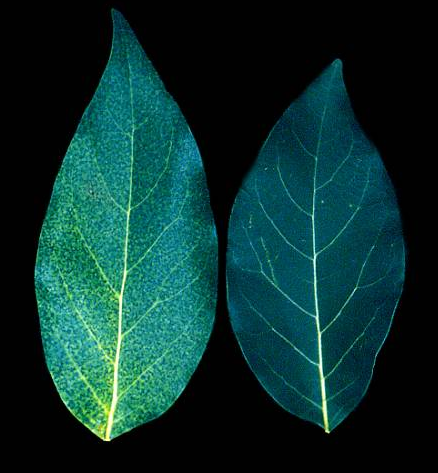
nitrogen avocado
2017 Date Field Day: A Success!
The University of California Cooperative Extension (UCCE), UC Riverside, United States Department of Agriculture/Agriculture Research Service (USDA/ARS), and the California Date Commission hosted a Date Field Day on February 15, 2017 at the UC Riverside Coachella Valley Agricultural Research Station. It was a full house that day, with approximately 55 Growers, farm managers, and other date stakeholders. The field day included a field research plot tour, lunch, and Continuing Education hours where available for attendees.
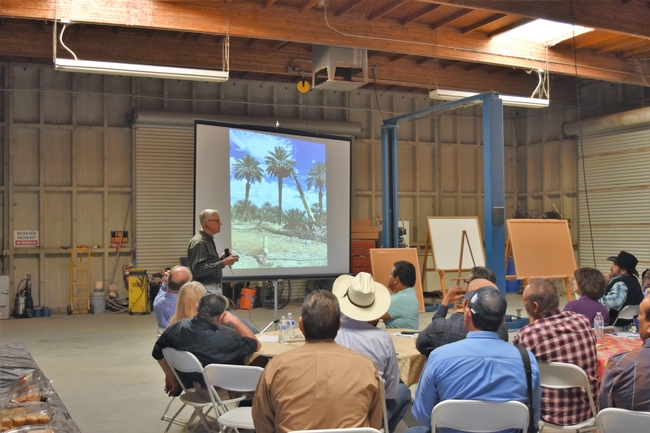
Robert Krueger, Citrus and date researcher Riverside USDA/ARS spoke about nitrogen assessment of date palms. He discussed diagnostic sampling implications, which suggest that there are differences in concentrations of various elements that occur in different portions of the leaf, and at different aged leaves can show different results, and also different seasons may also effect results. Based on the research it is suggested that the best sampling strategy is near khalal stage from middle pinnae of intermediate aged leaves during the summer.
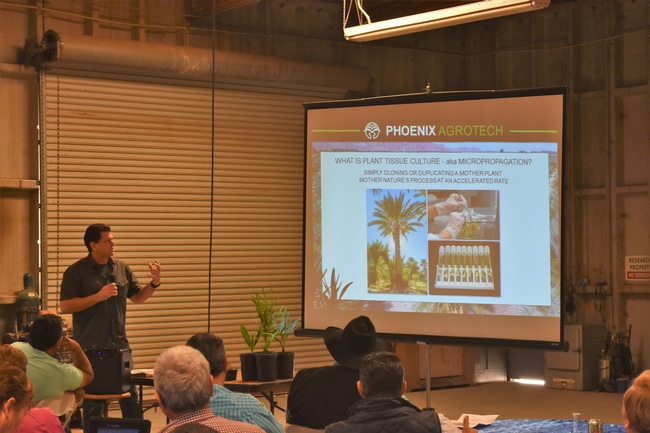
Peggy Mauk, UCCE-UCR Subtropical Horticulture Specialist spoke about establishment of date palms: Tissue Culture vs Off-shoots.
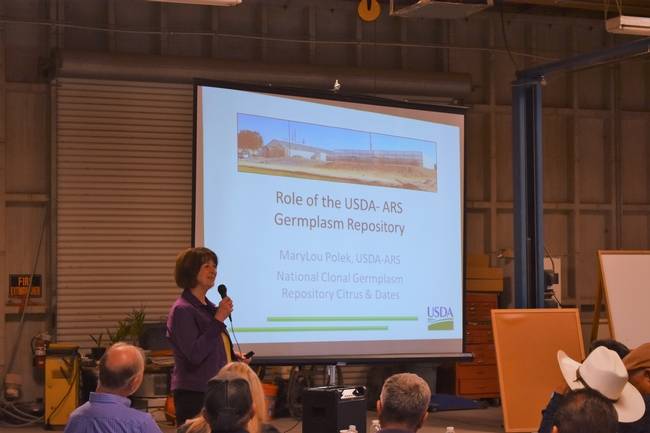
Sonia Rios, UCCE Riverside/San Diego Counties Subtropical Horticulture Farm Advisor spoke about pest issues in date palm, more specifically about weevils . Date palms flourish in high summer temperatures and low humidity which creates a perfect breeding ground and living conditions for pest, especially for the Red palm weevil (Rhynchophorus ferrugineus) (RPW) and South American palm weevil (Rhynchophorus palmarum) (SAPW). The RPW is considered most destructive arthropod pest of palms world-wide. SAPW causes similar damage on smaller scale. Both larvae's can cause economic damage as they feed on palm near apical growing point causing damage, which weakness the tree, and eventually causes death. The SAPW has been eradicated, however the RPW has been slowly showing up in date species in California, threatening the date industry. (Weevil Photos: Mark Hoddle)
The California date industry is worth ~$68 million (NASS, 2015). In 2015, 43,600 tons of dates where harvested. Coachella Valley produces about 95% of the dates consumed in the US. Date palms flourish in high summer temperatures and low humidity climates, which permits their production to certain growing regions. There are many threats to this economically important commodity and the University of California Cooperative Extension and other agencies are committed to assure the date industry thrives locally and globally. The planning committee looks forward to next year's event.
Copper? On Your Avocado Trees?
At a recent Fresh Index-sponsored meeting, David Crowley recently of UC Riverside talked of a five year-long study that assessed nutritional status and yield. This has been a study area that has long been confused by the problems of alternate bearing, weather-dependency of the avocado, soil variability, root rot, etc. etc. etc. that we all know about. There are nutrient interactions that confound results, as well. High phosphorus affects micronutrient uptake of zinc, copper and others. Zinc impedes copper uptake. Loss of roots from Phytophthora especially affects micronutrients. Irrigation and aeration again affects nutrient uptake, and especially micronutrients.
The elements coming from the soil are divided into primary nutrients, secondary nutrients and micronutrients. This grouping is based on the relative amounts required by plants, but all are essential. Crowley describes the relative need for each element being based on the “Law of the Minimum”; if only one element is deficient it eventually affects growth and yield of the entire plant in a negative manner. It doesn't matter how much the other nutrients are raised, if one is limiting, growth is limited by that one. The primary nutrients required by avocados are nitrogen, phosphorus and potassium. The secondary nutrients required are calcium, magnesium and sulfur. The micronutrients are zinc, iron, manganese, copper, boron, molybdenum, nickel and chlorine.
The Law applies not just to nutrients but to light, temperature, water, disease, pests – anything that affects growth. The limiting input needs to be fixed before the others can boost growth to whatever the biological maximum might be in that environment. In irrigated agriculture, water is the most common limiting input.
So, it is complex. Really complex. But with computers and different techniques of analysis and just looking at nutrients, Crowley has been able to get a better handle on what could be limiting growth in an individual grove. This applies not to what is lacking, but what might be in excess – too much chloride, too much nitrogen, too much…………….
So, in the case of all this data collection the Crowley team has done, something unusual has popped up. Copper deficiency.
Copper deficiency is not commonly recognized as a problem in California avocado groves, but occasionally a grower will report a leaf analysis showing less copper than the 5ppm recommended by Embleton (http://ucavo.ucr.edu/General/LeafAnalysis.html). Typical copper deficiency was reported by Barnard and others (http://www.avocadosource.com/Journals/SAAGA/SAAGA_1991/SAAGA_1991_PG_67-71.pdf). They reported the symptoms of copper deficiency as follows: • Dull appearance of older leaves • Prominent leaf veination • Reddish-brown leaf color • Premature defoliation and twig. This is an extreme case, and Crowley is suggesting there may be some low, chronic level that limits avocado. His final report can be found at:
Of course, why copper might be limiting is another question. Is it due to root rot? Interaction with other applied materials like phosphorus (not phosphite, phosphorous, phosphonate) fertilizers? With irrigation management? Something(s) to think about.
And citrus in California is a different beast. It can commonly show copper deficiency and be a limiting nutrient. We apply copper as a frost/brown rot/septoria spray and as a result don't often see deficiency in citrus.
Image
Liebig's Barrel. Optimum production occurs when all the barrel staves are as high as they can be. When one element is low, that becomes the limiting factor for production. Increased production doesn't occur until that uptake is improved and then the next limiting input restricts production. When that next one is corrected, then some other input then limits production. Correction keeps improving production until the biological limit is reached.
Have any readers actually seen a wooden barrel?
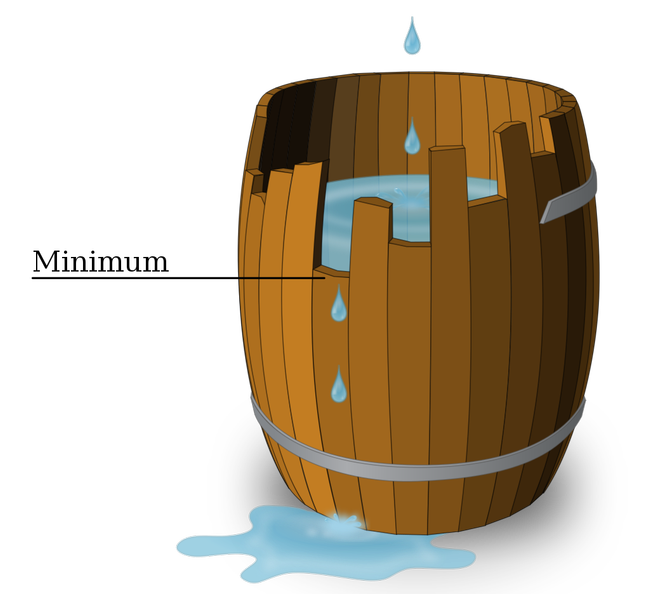
minimum nutrient
Citrus and Avocado Leaf Analysis
It’s that time of year when citrus and avocado growers need to collect leaf samples for nutrient analysis to guide fertilizer applications. Leaves are collected between August 15 and October 15 and sent to the lab for analysis. For perennial crops, leaf analysis is the most important guideline for managing tree nutrient applications. Many growers think that soil analysis is as important as leaf analysis, and is for annual crops, but is much less valuable for tree crops. Because a tree stores nutrients in its various parts, such as roots, trunk, branches, stems and leaves, it does not have to get all of its immediate nutrients from the soil the way a lettuce plant does. Trees also have a root association with beneficial fungi called mycorrhizae (fungus/roots) which aid in the uptake of nutrients such as phosphorus and zinc, and this ability is not reflected in a soil analysis. A leaf analysis integrates everything the tree is "seeing" – weather, soil, in-tree storage, water, crop load, disease – which is then reflected in the leaf analysis.
Leaf analysis is done at this period, because the leaf nutrients are somewhat stabilized. Young leaves are high in such nutrients as nitrogen and potassium, but low in zinc and iron. As the leaf matures it loses nitrogen and potassium, but gains in iron and zinc. A fully expanded four-month old leaf from the spring flush taken at this time of year has been found to best reflect the tree’s nutrient status. For a discussion on leaf sampling, see our fall 2003 edition of Topics in Subtropics - http://ceventura.ucdavis.edu/newsletterfiles/Topics_in_Subtropics3707.pdf.
If leaf nutrients are low or high, it can indicate not only what nutrient is the problem, but also what sort of corrective actions should be evaluated. It may not be the lack of something like iron, but waterlogging from too long or frequent irrigations. Waterlogged soils reduce iron uptake, and this deficiency might be better addressed by correcting the irrigation practice than spending money on iron applications. Zinc deficiency might be a result of root rot killing root hairs that take up zinc and addressing the disease issue is going to have a longer term improvement on tree nutrient status than simply applying zinc fertilizer. And then of course, if leaves are showing toxicities to sodium or chloride, correcting irrigation leaching and infiltration issues is the way to solve this nutrient problem, since this the easiest way to solve the problem.
This does not mean soil and water analyses are not important, on the contrary. A pre-plant analysis for water and soil can tell you before hand what you might be dealing with and allow you to correct the problem before planting. A high pH is best corrected before trees are in the ground. Trying to correct a zinc, iron, manganese, or copper deficiency with the trees in the ground is expensive and can take years to correct. It is easier to apply sulfur or sulfuric acid to the ground before planting and can be done relatively quickly without harm to the trees. The micronutrient availability is controlled by pH and once soil pH is in the 6-7 range, it is less likely for these deficiencies to occur. Trying to lower pH when the trees show iron deficiency, must be done slowly, since adding too much acidifying material at one time can kill the tree and during the process of acidification, some sort of stop gap measure, such as foliar feeding or fertigation must be employed until the soil pH has slowly been corrected. A water analysis too can forewarn you if you will be having problems with such things as high salinity, chloride, sodium, magnesium, boron or pH, and allow you to select appropriate rootstocks tolerant of the problem or again address it with soil amendments pre-plant.
A soil analysis in conjunction with water analysis can also be used for an ongoing determination of how well irrigation is being managed. Soil from trees doing poorly can be analyzed to see if adequate leaching is being accomplished with the frequency and amounts being applied. Generally, though, a soil analysis is a poor indicator of guiding a tree nutrition program and as an ongoing practice should be used for identifying the toxicity problems of salinity, boron, sodium, chloride and pH.
![S-AV-CULT-IR[1]](http://ucanr.edu/blogs/Topics/blogfiles/18095.jpg)
S-AV-CULT-IR[1]
Production quiz -- a challenge for growers
We’d like to challenge you to take the following quiz. Take a minute to place a check mark next to all the practices you regularly employ in your operation. Go ahead – we won’t be collecting them!
Part 1
Yes/ No I know what the nitrogen requirements (lbs actual N/acre/year or /tree/year) are for my crops
Yes/ No I know what the nitrogen levels are in soil amendments I use in my operation (compost, manure, crop residues, etc.)
Yes/ No I have lab analysis of my well/irrigation water.
Yes/ No I monitor tissue levels of nitrogen in my crops to help with fertilizer decisions.
Yes/ No I have put together a nutrient budget that considers all sources of nitrogen for the crops I produce.
Part 2
Yes/ No When I do apply nitrogen, applications are timed according to crop requirements.
Yes/ No I use fertigation to apply nitrogen.
Yes/ No Applications of nitrogen are split into smaller doses to improve efficiency of uptake.
Yes/ No I use cover crops that help manage nitrogen availability.
Yes/ No I manage irrigations to avoid nutrient loss below the rootzone of the crop.
If you marked yes to these as regular activities, you’ve just taken steps in showing how your production decisions can protect water quality. The combined activities noted in Part 1 constitute a Management Practice that protects water quality by developing a nutrient budget to help apply only the appropriate amounts of fertilizer. Activities in Part 2 may alone or in combination constitute Management Practices that help ensure fertilizers are applied efficiently.
Every grower uses ‘management practices’, many of which are meant to generate the best possible product for market. Depending on who you’re talking with, the term ‘management practice’ can be something your Farm Advisor recommends (i.e., pruning to control tree height), your produce buyer suggests (protect avocados in bins from sun scald), or the term can have regulatory connotations.
You’ve all probably heard the term Best Management Practices. Best Management Practice (BMP) is defined in the Federal Clean Water Act of 1987, as “a practice or combination of practices that is determined by a state to be the most effective means of preventing or reducing the amount of pollution generated by nonpoint sources to a level compatible with water quality goals.” The term “best” is subject to interpretation and point of view. In recognition of this, the Coastal Zone Reauthorization Amendment (2000) substituted the terms Management Measures and Management Practices.
How can you tell if any individual activity constitutes a Management Practice that meets the needs of a regulatory program to protect water quality? Ask yourself this question: Can the activity stand alone and result in water quality benefits? Just knowing the nitrogen requirements of your crop doesn’t result in any water quality benefits – developing and using a nitrogen budget for your crop can. A nitrogen budget that takes into account the nutrients applied in amendments, irrigation water, and fertilizers in meeting the requirements of your crop does have the potential to protect water quality from nitrogen pollution from your operation.
Some Management Practices can have water quality benefits as a stand alone activity. Cover crops are recognized as a Management Practice that can help manage both sediment and nutrients to reduce the potential of pollution when used appropriately.
Water quality protection is being asked of all industries in California. You have the opportunity to take credit for all of the activities you already do, like the ones listed above, that protect your local water bodies and/or groundwater from nonpoint source pollution from your operation. Look for additional articles in the coming issues to help you in this effort.
For additional background information on water quality legislation, and nonpoint source pollution from agriculture you can download the following free publications from the University of California’s Farm Water Quality Program:
Water Pollution Control Legislation
Nonpoint Sources of Pollution from Irrigated Agriculture
